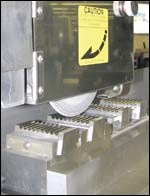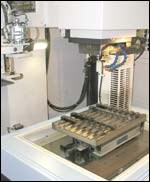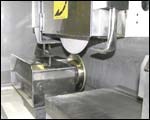PC-Based Surface Grinders Make Their Mark
A more effective approach to grinding complex profiles enables this shop to help its U.S. customers compete globally.
Share




No. 2 pencils, belt loops and peanut butter have something in common: They can all be produced more economically in the United States thanks to the work of Carbide Products, Inc., in Georgetown, Kentucky. This shop specializes in carbide and steel tooling plus related products, including those that help manufacturers of wood-encased pencils, fabric belt loops and peanut butter. The shop’s innovative use of CNC surface grinders has been a key enabler in this effort.
Carbide Products, which employs 38 people in its shop and front office, supplies cutters to every pencil manufacturer in the United States and to pencil makers in 26 countries around the world. These cutters, which consist of a cutting head and matched set of carbide or HSS blades, shape wooden slats into the pieces that encase a slender core of compressed graphite to make a pencil. Cutters from Carbide Products are designed and manufactured in such a way that their performance and quick-change features significantly enhance the productivity of the fundamental pencil-making process. These efficiencies have enabled many of the U.S. pencil manufacturers to compete more effectively with offshore producers, helping to save an industry that has a long tradition and provides numerous jobs.
Carbide Products is using two new grinders to streamline production of the cutting blades and make the process more flexible. Built in Japan by Mitsui High-Tec, the grinders were introduced only last year. Carbide Products is home to two of the first three of these machines installed in any U.S. shop. In fact, the company helped the builder refine and enhance the software in the PC-based control system to make it more compatible with user expectations in this country. Now incorporated as standard features of the software, these enhancements are helping the shop deliver the cutting tools so crucial to pencil manufacturers.
Carbide Products’ contributions to the production of belt loops and peanut butter are not quite so dramatic, but both applications highlight the company’s reliance on grinding as only one of its strengths in machining technology. For example, the company not only makes the tool steel dies that cut fabric into the patterns that are folded and stitched into belt loops by high speed sewing machines, but it also produces the entire die-cutting assembly as a drop-in unit for the cloth cutting machine builder. This complex assembly is comprised of components that the shop manufactures on its CNC mills, surface grinders, profile grinders, centerless grinders and electrical discharge machines. The completed assemblies are also tested in-house before shipment.
A similar story can be told about the valves the shop produces for one of America’s premier processors of peanut butter. This processor’s Lexington, Kentucky, plant relies on various types of valves from Carbide Products to operate the equipment for homogenizing the peanut butter blend and dispensing it into jars. This equipment has to be maintained to extremely high standards for cleanliness yet operate reliably at high speed. The valves incorporate moving parts of carbide whose tight tolerances (±0.0002 inch on flatness for certain styles) ensure proper flow of the product in the mixing and dispensing chambers. Peanut butter, it turns out, is an abrasive material in various stages of its processing, so the shop also handles refurbishing of worn valve parts. It also produces steel and food-grade plastic components for container filling machinery.
Of course, there is more to this company’s business than pencils, belt loops and peanut butter. The company has about 150 active customers in a dozen industries that produce light bulbs, ball bearings, medical parts and sporting goods (the carbide and HSS knives used to shape some of the famous Louisville Slugger baseball bats are manufactured by Carbide Products).
A Grandfather’s Legacy
Brothers Danny and Paul Strippelhoff are the owners of Carbide Products. Danny is president and Paul is vice president of manufacturing. Their grandfather, Henry Strippelhoff, founded the company in 1943 as a tool and die shop. He completed his tool and die making apprenticeship and studied mechanical engineering in Essen, Germany, before coming to the United States prior to the Second World War. The younger Strippelhoffs became toolmakers under his tutelage, and they credit him for establishing their pride of craftsmanship and regard for advanced technology. Both consider these two elements essential to the shop’s success.
“Having equipment with the right capability is important, but being creative and inventive with it is the other half of the picture,” says Danny Strippelhoff.
The new CNC grinders are a case in point. They are an integral part of the company’s pencil tooling strategy.
Carbide Products has been serving the pencil industry for more than 50 years. The common wood pencil is a complex product manufactured in a wide variety of styles on precision machinery to high quality standards. Like many mature industries in the United States, pencil manufacturing has come under extreme pressures from low-cost producers overseas. U.S. manufacturers have responded by streamlining production and controlling costs. This is where cutting tools from the shop in Kentucky fit in.
“Our carbide and HSS cutting blades help minimize downtime for the equipment that machines the wooden casing,” explains Paul Strippelhoff. “The blades can be exchanged in less than 5 minutes because the cutter head stays in the machine. In addition, the blades are designed so that they can be resharpened quickly and easily on a surface grinder. This means highly skilled tradesman aren’t needed to keep the woodworking equipment running.” Because pencil manufacturers are losing their skilled personnel to retirement and attrition, this last benefit is growing in importance.
The cutting blades also help make the woodworking equipment more productive. The accuracy and consistency of the ground cutting edges shape the wood more uniformly, allowing cutting speed to be increased and reducing scrap. Whether made of carbide or HSS, these blades last longer because of their quality, says Mr. Strippelhoff. Because the distinctive incense cedar traditionally found in wood pencils is now scarce, manufacturers are using other species of wood. However, these materials are more abrasive, causing high tool wear. This means more frequent tool changes, making quick-change tooling all the more important.
Producing the cutting blades, however, represents a number of challenges for Carbide Products. Every pencil manufacturer has specific designs for its products. For example, the typical six-sided pencil shaft has a number of design variables—the width of the side panels, the corner radii, whether the panels are slightly convex and so on. This means that the shop must be able to produce highly customized sets of cutting blades for each manufacturer. Moreover, each blade has to be profiled to produce the exact shape while cutting at a rake angle. The geometry is further complicated by the need to grind in a slight relief on the cutting edges for clearance, which influences the life of the blade.
In the past, the shop used templates made from steel gauge stock as guides to form the grinding wheels on 10:1 ratio pantograph-type wheel dressing units. The profile of the template, ten times larger than the desired blade shape, was transferred to the contour of the grinding wheel in the correct scale. The entire process, done on manual/hydraulic equipment, was time-consuming and dependent on operator skill. The blades were then ground on hydraulic surface grinders.
The Strippelhoffs recognized that keeping their costs down was necessary to support their customers’ efforts to compete. This led them to look for ways to revamp their grinding methods. The new grinders broke this bottleneck by automating both the wheel dressing process and the grinding cycle.
New Direction
These grinders represent a new direction for Mitsui High-tec. The parent company is one of Japan’s leading suppliers of leadframes for integrated circuits. It began building high-precision surface grinders many years ago because commercially available grinders were not adequate or affordable for producing stamping die components, which required accuracies to the micron level. These grinders were soon being sold to companies in the electronics industry, as well as to manufacturers serving other industries.
To offset the cyclical nature of demand for its high-end grinders, the company was determined to produce grinders for the broader general machining market. The goal was to develop a moderately priced grinder capable of precision only slightly below that of the builder’s high-end grinders. The PC-based control system was also designed to make it easy for users to make the transition from manual surface grinders to CNC operation. The graphical interface was intended to simplify setup and operation, and this feature inspired the QuickSet name for these models.
These QuickSet grinders were exactly the kind the Strippelhoffs imagined for their approach to streamlined blade production. The brothers were especially interested in the PC interface because the prospective operators at Carbide Products had little or no experience with CNC surface grinders. The shop installed the first QuickSet grinder in May 2005. An identical machine was installed the following August.
Because the original grinder was among the first of its kind in North America, Paul Strippelhoff and his grinding staff worked closely with Bob Hamada, sales manager for Mitsui High-Tec (USA) in Elk Grove Village, Illinois, to prove out the English language version of the control software. Mr. Strippelhoff offered suggestions for an additional menu page that would allow the operator to enter grinding wheel offsets in a more intuitive manner. Other modifications were also suggested to conform to shop practices in this country.
One of the key features of the grinders is an optional automatic wheel dressing unit that uses a rotary diamond wheel to dress the profile of the grinding wheel. This profile is responsible for shaping the blades properly to cut the exact form dictated by the pencil manufacturer. This system does not require the steel templates formerly used.
“Now, the operator can download a dressing program from a file server on our Ethernet shop network,” Mr. Strippelhoff explains. The diamond wheel follows the programmed tool path to profile the grinding wheel. Although the initial cost of the diamond wheel is high, the shop no longer uses the single point dressing tools that needed replacing three times a week. Dressing programs are created off-line using Esprit CAM software from DP Technology (Amarillo, California). According to Mr. Strippelhoff, this software can project the geometry along the rake and relief angles so that the resulting blade profile cuts true to form.
After the wheel is dressed, the operator enters variables for the grinding cycle at the control panel and is ready to begin. “Because we are often grinding carbide, we wanted a grinder with the weight and rigidity to handle the grinding forces. We like the heavy construction of the column and saddle on these machines,” Mr. Strippelhoff says.
Beyond Grinding
Because the grinders can be set up and programmed quickly, they are attracting other jobs from within the shop. According to Mr. Strippelhoff, this flexibility helps the company keep to its production schedule. Some work originally slated for wire EDM, for example, is occasionally diverted to the grinders when they are open and the EDM units are booked. The grinders can also finish details that cannot be hard turned, such as the 0.005-inch inside corner radius on core pins for die-casting molds.
This raises another point that Danny Strippelhoff likes to stress. “We are grinding specialists, but being strong in other advanced machining processes lets us offer more to our customers and serve a broader customer base,” he says. He cites hard turning as a case in point. The company produces customized core pins for die-casting molds that are hard turned on a GT27SP turn/mill machine from Hardinge (Elmira, New York). These pins, with a hardness of 55-60 Rockwell C, are turned from solid barstock. Some pins with high length-to-diameter ratios must still be ground, however, proving that capability in these complimentary processes pays off.
Wire and ram EDM is another area where keeping up with current technology has benefited the shop’s overall capability. Because copper tungsten is a better electrode material than graphite for eroding carbide, the shop is proficient at milling and turning this material. A Progress 2 five-axis wire electrical discharge machine from Agie (Lincolnshire, Illinois) provides high speed wire cutting (as fast as 47 square inches per hour in steel, according to the machine builder). An Agie Evolution FS+F wire machine is capable of cutting with wire as small as 0.001 inch in diameter, although most applications call for standard wire sizes. Both machines are used routinely to cut carbide.
The key to wire-cutting carbide, says Mr. Strippelhoff, is managing the effects of internal stresses released in the carbide workpiece as it is being cut. This is a matter of planning for movement in part shape and adjusting the wire path and skim cuts accordingly, based on prior experience and thorough documentation. Choosing the right grade of carbide is also essential to successful wire cutting.
Finally, the shop has in-house facilities for brazing carbide, a key process for assembling complete tooling packages. Removing and regrinding carbide inserts to refurbish tooling is a steady business; brazing allows the tooling pieces to be reassembled in virtually as-new condition.
Yet despite this focus on technology, the Strippelhoffs emphasize that a skilled workforce ultimately makes the difference. That’s why the slogan “Where Craftsmanship & Technology Meet” is posted under the company logo at the front entrance of the building.
Related Content
CNC Machine Shop Honored for Automation, Machine Monitoring
From cobots to machine monitoring, this Top Shop honoree shows that machining technology is about more than the machine tool.
Read MoreInside the Premium Machine Shop Making Fasteners
AMPG can’t help but take risks — its management doesn’t know how to run machines. But these risks have enabled it to become a runaway success in its market.
Read MoreHow to Determine the Currently Active Work Offset Number
Determining the currently active work offset number is practical when the program zero point is changing between workpieces in a production run.
Read MoreInside a CNC-Machined Gothic Monastery in Wyoming
An inside look into the Carmelite Monks of Wyoming, who are combining centuries-old Gothic architectural principles with modern CNC machining to build a monastery in the mountains of Wyoming.
Read MoreRead Next
5 Rules of Thumb for Buying CNC Machine Tools
Use these tips to carefully plan your machine tool purchases and to avoid regretting your decision later.
Read MoreBuilding Out a Foundation for Student Machinists
Autodesk and Haas have teamed up to produce an introductory course for students that covers the basics of CAD, CAM and CNC while providing them with a portfolio part.
Read MoreRegistration Now Open for the Precision Machining Technology Show (PMTS) 2025
The precision machining industry’s premier event returns to Cleveland, OH, April 1-3.
Read More





































